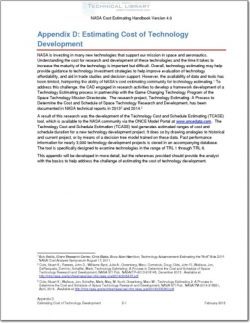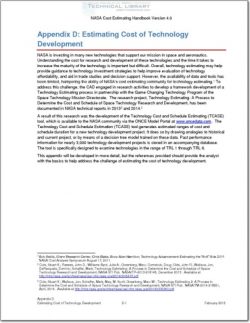NASA-CEH-APP-D

- Version
- 211 Downloads
- 126.39 KB File Size
- 1 File Count
- August 14, 2016 Create Date
- August 14, 2016 Last Updated
Appendix D; Estimating Cost of Technology Development

NASA is investing in many new technologies that support our mission in space and aeronautics.
Understanding the cost for research and development of these technologies and the time it takes to
increase the maturity of the technology is important but difficult. Overall, technology estimating may help
provide guidance to technology investment strategies to help improve evaluation of technology
affordability, and aid in trade studies and decision support. However, the availability of data and tools has
been limited, hampering the ability of NASA‘s cost estimating community for technology estimating.1 To
address this challenge, the CAD engaged in research activities to develop a framework development of a
Technology Estimating process in partnership with the Game Changing Technology Program of the
Space Technology Mission Directorate. The research project, Technology Estimating: A Process to
Determine the Cost and Schedule of Space Technology Research and Development, has been
documented in NASA technical reports in 20132 and 2014.3
A result of this research was the development of the Technology Cost and Schedule Estimating (TCASE)
tool, which is available to the NASA community via the ONCE Model Portal at www.0ncedata.com. The
Technology Cost and Schedule Estimation (TCASE) tool generates estimated ranges of cost and
schedule duration for a new technology development project. It does so by drawing analogies to historical
and current project, or by means of a decision tree model trained on these data. Past performance
information for nearly 3,000 technology development projects is stored in an accompanying database.
The tool is specifically designed to examine technologies in the range of TRL 1 through TRL 6.
This appendix will be developed in more detail, but the references provided should provide the analyst
with the basics to help address the challenge of estimating the cost of technology development.
| File | Action |
|---|---|
| NASA-CEH-APP-D Appendix D; Estimating Cost of Technology Development.pdf | Download |

Comment On This Post